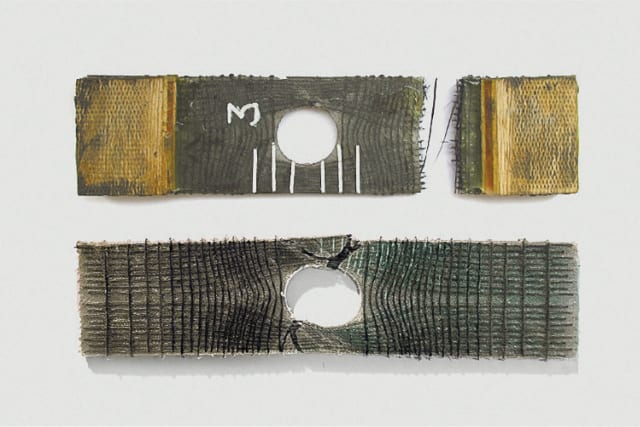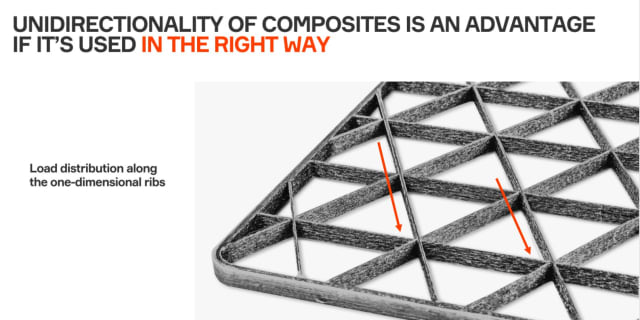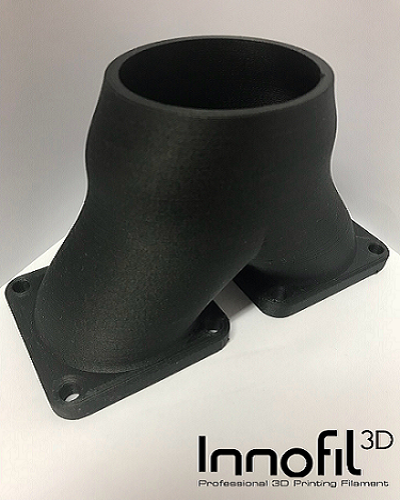Carbon Fiber 3D Printing, Part Two: Continuous vs. Chopped Desktop 3D Printing
In the first part of our series on carbon fiber 3D printing, we really only just got started by providing a background on the material, some of its properties, and how it’s made. Now that that’s out of the way, we can get to the fun stuff: how carbon fiber is currently available in the 3D printing industry.
Carbon Fiber Filaments
The most widely accessible form of carbon fiber in 3D printing is chopped carbon fiber filament. There are a wide variety of chopped carbon fiber blends available, with 3DXTECH offering some of the most diverse types that include high temperature thermoplastics as the matrix material. For instance, it’s possible to buy, PA, PEKK, PEEK, and PEI (ULTEM) filaments filled with chopped carbon fiber.
In chopped carbon fiber filament, segments of carbon fiber are mixed with thermoplastic pellets and then extruded into filament suited for extrusion 3D printing. Because the carbon fiber is broken, and not in continuous strands, it only offers the stiffness of carbon fiber at the points where those very small fragments are located.
Nevertheless, the introduction of carbon fiber into thermoplastic filament can improve its strength and stiffness but may also have negative effects, as well. One team of researchers found that, in addition to the desired strength, a PEEK-carbon fiber composite had more porosity and poor adhesion between printed layers. Another group found similar results with chopped carbon fiber in resin for stereolithography, including increased brittleness.
This doesn’t mean that chopped carbon fiber filament (or resin) doesn’t have value in 3D printing, particularly since it is much cheaper than the technologies that we will be going on to discuss. However, we will see in part three of this series how even these materials can be improved with some pretty ingenious thinking.
Continuous Carbon Fiber 3D Printing
In 2014, Markforged introduced continuous filament fabrication (CFF) to the world. In CFF, carbon fiber is pre-impregnated with a thermoplastic nylon, which is deposited from a specialty extruder. This is then used to provide reinforcement for plastic parts, including the firm’s own brand of chopped carbon fiber filament, Onyx.
More recently, a Russian company called Anisoprint has commercialized its own version of continuous carbon fiber printing dubbed composite fiber coextrusion (CFC). Unlike CFF, which features one input and one output for its prepreg material, CFC uses two inputs and one output. One input is dedicated to reinforcement fiber and the other is used for feeding thermoplastic. Dry fiber is fed into the system, where it is impregnated with an extremely liquid thermoset resin. During printing, the thermoset is cured and extruded together with traditional thermoplastic filament. The thermoset matrix permeating the reinforcement fiber then bonds with the filament.
As a result, not only is there less of a chance of introducing air bubbles or voids in the prepreg material, but it also opens up the variety of thermoplastics that CFC can use (so far, PETG, ABS, PC, PLA and PA).
The rate of deposition can also be controlled in CFC to generate interesting structures and properties not achievable with traditional composite manufacturing, such as lattice shapes. In crossing one strand of carbon tow over another, in traditional circumstances, the thickness of that area is doubled. With CFC, it’s possible to reduce the thermoplastic being extruded, while still depositing the carbon fiber, reducing the amount of plastic in that area.

Strength is evenly distributed around the hole, but not in the entire structure in part one, causing it to sheer. In part two, the entire part is reinforced in a crisscross fashion.
This, in turn, increases what is known as the “fiber volume ratio”, the amount of fiber reinforcement there is in relation to the total volume of the composite. A higher fiber volume ratio usually means improved mechanical properties. So, as these carbon fibers are crisscrossed in a 3D-printed lattice structure, the fiber volume ratio increases, as does the strength.
In aerospace, engineers seek fiber volume ratios of up to 60 percent or so. However, with other carbon fiber 3D printing technologies, the ratio is closer to 30 to 40 percent. Without lattice structures, CFC can achieve about 45 percent, but, at points where carbon fibers overlap, this ratio is doubled—that is, even stronger than available with traditional composites.

With minimal thermoplastic deposition in one direction, this part has less material but improved strength.
In woven carbon fiber, multiple layers of unidirectional fibers crisscross to mimic isotropy, which ends up providing omnidirectional strength at the expense of excess material. However, with CFC, it is possible to only add material and strength where necessary. For this reason, Anisoprint highlights the anisotropy of carbon fiber as a benefit, rather than a weakness—hence the name “Anisoprint.”
Since Markforged and Anisoprint have come to market, a third challenger has appeared with its own form of continuous carbon fiber printing. Ahead of Formnext 2019, Desktop Metal introduced a technology called micro automated fiber replacement (μAFP). μAFP relies on two print heads: one deposits thermoplastic filament and then a tool changer swaps to the other, which lays down prepreg tape, similar to the automated fiber placement technology mentioned briefly in part one.
The carbon fiber-thermoplastic tape is first heated to above the melt temperature of the plastic. Then, a roller presses the tape onto the printed part. The combination of heat, pressure and then the cooling of the printed part, allows the tape the part to fuse.
Desktop Metal is releasing the technology with the Fiber HT and Fiber LT 3D printers. The LT is available as with a $3,495 annual subscription and prints PA6-carbon fiber or PA6-fiberglass tape. The HT ($5,495 per year), can not only print with those tapes, but also PEEK or PEKK combined with carbon fiber or fiberglass. The HT also has two printheads, while the LT has just one.
Additionally, the Fiber HT includes the ability to manage the orientation of the fibers using advanced settings in its software, can achieve less than one percent porosity, and can print with a fiber volume ratio of up to 60 percent.
Large Format and Experimental Carbon Fiber 3D Printing
Also at Formnext, Anisoprint unveiled its production scale CFC system, the Anisoprint ProM IS 500. With a build volume of 600 mm x 420 mm x 300 mm, the system has a heated build chamber capable of printing PEEK and PEI, as well as automated calibration and other production-quality features. With four swappable printheads, it will also be able to combine different composite materials, in addition to carbon fiber. The system will also feature software for optimizing the printing of lattice structures. Anisoprint aims to ship its first ProM IS 500 systems at the end of 2020.
While this is the Russian company’s first production-level carbon fiber 3D printer, it may face some stiff competition. There are a number of other firms that are working on their own unique takes on carbon fiber 3D printing. Because they differ distinctly from the types discussed here, we will explore them in the next chapter of our saga.
Join the discussion of this and other 3D printing topics at 3DPrintBoard.com.
Subscribe to Our Email Newsletter
Stay up-to-date on all the latest news from the 3D printing industry and receive information and offers from third party vendors.
Print Services
You May Also Like
New Business: Temporary, Migratory, & Modular 3D Printed Architecture
If we look at potentially emerging 3D printing businesses, then architecture has not been fully explored. Yes, there is a lot of house 3D printing going on worldwide. From deployable...
3D Printing News Briefs, April 19, 2025: Material Extrusion Standard, Metal Powder, & More
In today’s 3D Printing News Briefs, we’re covering a proposed standard for material extrusion, before moving on to business and metal powder. We’ll end with a commercial store’s robotic 3D...
Japan Unveils World’s First 3D Printed Train Station
Japan is now home to what we believe is the world’s first train station built with 3D printing technology. Located in Arida City, just south of Osaka, the new Hatsushima...
restor3d Raises $38M to Expand 3D Printed Orthopedic Implants
Backed by $38 million in new funding, restor3d is pushing ahead with the launch of four personalized implant lines, set to roll out in 2025 and 2026. This latest venture...



























